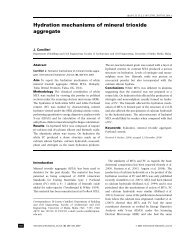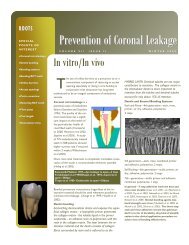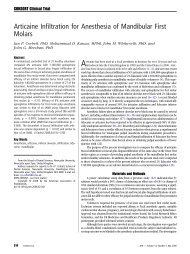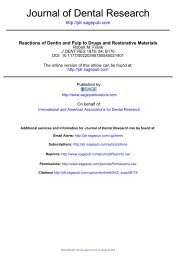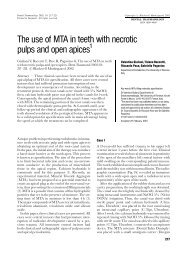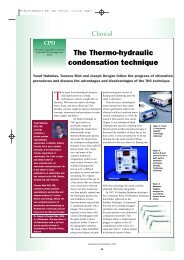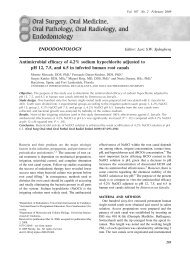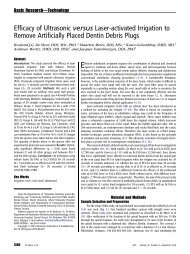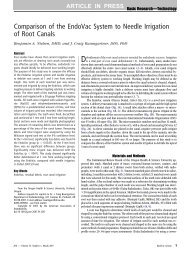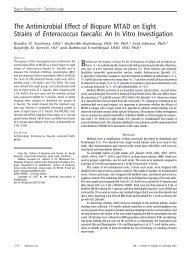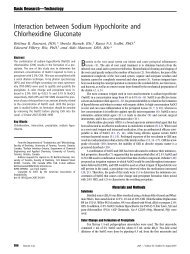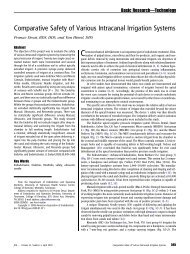Dens invaginatus - The EndoExperience
Dens invaginatus - The EndoExperience
Dens invaginatus - The EndoExperience
Create successful ePaper yourself
Turn your PDF publications into a flip-book with our unique Google optimized e-Paper software.
84 M. Hülsmann<br />
Fig. 5 (a) Small coronal invagination in tooth 22. (b) Three years later arrest of root development and pulp necrosis, with apical periodontitis, and<br />
sinus tract have appeared. (c) Fifteen months later: following apexification therapy with calcium hydroxide and obturation of the root canal the<br />
periapical status has improved.<br />
Root canal treatment<br />
A review of the literature shows that extraction of teeth<br />
with invaginations was the preferred therapy until the<br />
1970s (Hülsmann 1995a). Grossman (1974) and<br />
Creaven (1975) were the first to describe root canal<br />
Table 2 Dental anomalies described in association with dens <strong>invaginatus</strong><br />
Microdontia Casamassimo et al. 1978<br />
Macrodontia Ekman-Westberg & Julin 1974<br />
Hypodontia Hülsmann 1995c<br />
Oligodontia Conklin 1978, Ruprecht et al. 1986<br />
Taurodontism Casamassimo et al. 1978,<br />
Ruprecht et al.1986,<br />
Ireland et al. 1987,<br />
Chen et al. 1990<br />
Gemination and Fusion Burzynski 1973, Mader 1979,<br />
Mader & Zielke 1982,<br />
Ruprecht et al. 1986<br />
Supernumerary teeth Schaefer 1953, 1955,<br />
Brabant & Klees 1956,<br />
Petz 1956, Rushton 1958,<br />
Conklin 1975, Mader<br />
1977, Shifman & Tamir 1979,<br />
Beynon 1982, Ruprecht et al. 1986,<br />
Morfis 1992<br />
Amelogenesis imperfecta Kerebel et al. 1983<br />
Invagination in an odontome Hitchin & McHugh 1954<br />
Multiple odontomes Robbins & Keene 1964<br />
Coronal agenesis Hicks & Flaitz 1985<br />
Williams syndrome Oncag et al. 1995<br />
treatment of the invagination only (root invagination<br />
treatment) and Tagger (1977) and Hovland & Block<br />
(1977) the first to present cases treated with conventional<br />
root canal therapy (Fig. 7a,b). Root canal treatment<br />
may present several problems because of the<br />
irregular shape of the root canal system(s). If there<br />
are no radiographic signs of pulp pathosis and no<br />
communication between the invagination and the<br />
root canal, root canal treatment or, in minor cases, even<br />
a composite or amalgam filling of the invagination will<br />
be adequate (DeSmit & Demaut 1982). When the invagination<br />
has a separate apical or lateral foramen, root<br />
canal treatment of the invagination is indicated<br />
(Grossman 1974, Creaven 1975, Bolanos et al. 1988,<br />
Szajkis & Kaufman 1993, Wells & Meyer 1993, Ikeda<br />
et al. 1995). In some cases it may be possible to bur<br />
through the invagination to get access to the apical<br />
foramen. When these minor forms of invaginations<br />
are eliminated root canal therapy in most cases will<br />
not present further problems. In certain cases the invagination<br />
has to be treated as a separate root canal (Cole<br />
et al. 1978, Zillich et al. 1983, Eldeeb 1984, Greenfield<br />
& Cambruzzi 1986, Mangani & Ruddle 1994, Khabbaz<br />
et al. 1995).<br />
When pulp necrosis occurs before root-end closure,<br />
apexification procedures with calcium hydroxide may be<br />
necessary (Ferguson et al. 1980, Morfis & Lentzari 1989,<br />
Vairabhaya 1989, Hülsmann & Radlanski 1994,<br />
Nagatani et al. 1995) (Fig. 5a–c).<br />
© 1997 Blackwell Science Ltd, International Endodontic Journal, 30, 79–90



